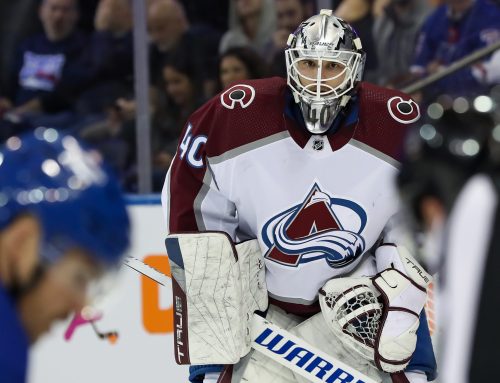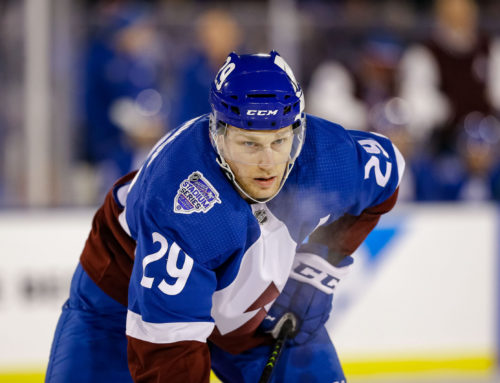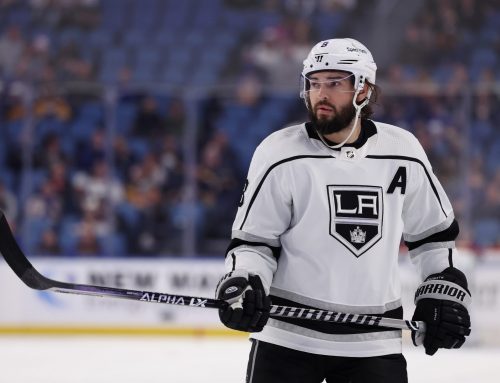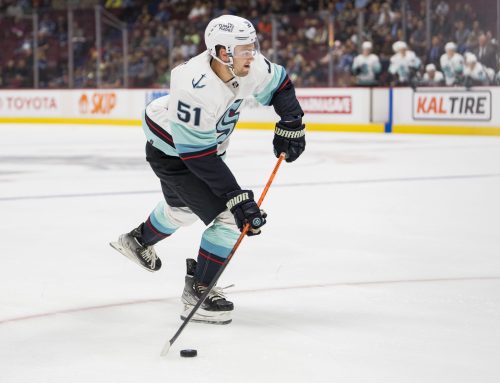Powerful or Powerless
Doran Libin
2015-11-09

Taking a close look at the power play of the Wild, Blues, Stars, Ducks, Coyotes and Blackhawks…
This week the focus turns to power plays as two of best, two of the worst and two of most interesting are featured. Listed for each team is any player receiving two or more minutes per game as that is the minimum for any player amount of power play time for it to significantly affect their point totals. A player on the first unit of a power play that is clicking can count on adding 20 points on top of their even strength point totals. Those on the best units can rack up another 10 to 20 points on top of that. The opposite is also true, it does not matter how much power play time a player receives if that power play does not produce goals. Power plays, however, are often fickle beasts as the success of a unit, and the fortunes of the players within, can change drastically from year to year.
Minnesota Wild (21.7%)
|
Name |
Games |
PP TOI |
PP Pts |
PP P60 |
PP SF60 |
PP On-ice SH% |
|
13 |
3.72 |
5 |
6.21 |
40.97 |
18.18% |
|
|
13 |
3.54 |
4 |
5.21 |
43 |
18.18% |
|
|
12 |
3.54 |
4 |
5.64 |
42.33 |
16.67% |
|
|
13 |
3.47 |
2 |
2.66 |
39.87 |
20% |
|
|
13 |
3.44 |
2 |
2.68 |
41.56 |
19.35% |
|
|
13 |
2.12 |
3 |
5.64 |
45.79 |
19.05% |
The Minnesota Wild is a great example of that last point, as they went from a bottom-feeding unit last year to a top ten unit this year. Oddly though they are not generating a ton of shots while on the power play nor are they generating a lot of power play opportunities. The ability to generate shots at a high volume is almost without fail the mark of a consistently high-end power play; the Capitals for example have been over 60 shots per 60 minutes on the power play in five of the previous seven seasons. The Wild are compensating for the lack of shots with high on-ice shooting percentages across the board. That is concerning especially since they are bottom five in the league at generating high danger chances while on the power play and only middle of the pack at generating scoring chances. Wild players that are heavily reliant on the power play for their points may be in trouble in the long run.
Dallas Stars (28.9%)
|
Name |
Games |
PP TOI |
PP Pts |
PP P60 |
PP SF60 |
PP On-ice SH% |
|
15 |
3.3 |
6 |
7.27 |
59.39 |
18.37% |
|
|
15 |
3.22 |
5 |
6.2 |
60.79 |
18.37% |
|
|
15 |
3.15 |
6 |
7.61 |
60.88 |
18.75% |
|
|
15 |
3.13 |
3 |
3.84 |
60.14 |
19.15% |
|
|
15 |
3.07 |
6 |
7.83 |
62.61 |
18.75% |
The Stars have been an offensive juggernaut this season both on the power play and at even strength. The power play has been especially effective as it has scored on nearly 30% of its opportunities, which is especially impressive as they are top ten in the league in power play opportunities. The Stars are also generating shots while on the power play at a prodigious rate. Generating lots of shots is great especially when the Stars are also one of the best teams at generating scoring chances, third best in the league. That combination of factors suggest that the high on-ice shooting percentages are not as over blown as they might otherwise be. Furthermore, there is a clear top unit based on the way the power play time is doled out on this team. There is at least a minute and a half difference between the five players listed here and the player with the sixth most power play time on the Stars. Any Dallas player finding himself on the top unit should be able to ride this unit to at least 20 points for the season, it looks that good.
Arizona (11.3%)
|
Name |
Games |
PP TOI |
PP Pts |
PP P60 |
PP SF60 |
PP On-ice SH% |
|
13 |
6.49 |
2 |
1.42 |
52.66 |
8.11% |
|
|
13 |
4.56 |
1 |
1.01 |
57.68 |
5.26% |
|
|
11 |
4.41 |
3 |
3.71 |
59.36 |
6.25% |
|
|
13 |
3.83 |
3 |
3.61 |
56.59 |
8.51% |
|
|
13 |
3.54 |
2 |
2.61 |
53.43 |
7.32% |
|
|
Mike Stone |
13 |
3.19 |
2 |
2.89 |
41.89 |
6.9% |
|
13 |
3.04 |
3 |
4.55 |
51.61 |
8.82% |
|
|
8 |
2.98 |
0 |
0 |
47.83 |
5.26% |
|
|
13 |
2.76 |
1 |
1.67 |
50.16 |
6.67% |
Arizona is the best example of a traditionally strong power play suffering and bringing down the constituent members of the unit. It is interesting to note that the underlying numbers for the Coyotes’ power play have not changed significantly as their shot rate, scoring chance rate and high danger shot rate have remained virtually unchanged. The big drop has been in the respective on-ice shooting percentages of the individuals on the unit. With no member of the top unit posting an on-ice shooting percentage over nine percent it is no wonder they are struggling. As is likely evident by OEL’s power play ice time the Coyotes are getting lots of power play opportunities each game. Boedker was recently removed from the top unit for a couple games but returned recently, suggesting that the coaches are trying to find the right with Yandle having moved on. Regardless the on-ice shooting percentages should rise but this does not look like engine that in recent years drove the Coyotes’ offense.
Anaheim (11.9%)
|
Name |
Games |
PP TOI |
PP Pts |
PP P60 |
PP SF60 |
PP On-ice SH% |
|
14
📢 advertisement:
|
2.82 |
1 |
1.52 |
51.73 |
5.88% |
|
|
14 |
2.76 |
0 |
0 |
49.77 |
6.25% |
|
|
14 |
2.55 |
1 |
1.68 |
47.07 |
7.14% |
|
|
14 |
2.48 |
2 |
3.45 |
55.2 |
9.38% |
|
|
10 |
2.32 |
1 |
2.59 |
59.53 |
4.35% |
|
|
13 |
2.04 |
1 |
2.26 |
56.43 |
4% |
|
|
14 |
2.01 |
1 |
2.13 |
48.98 |
8.7% |
The Ducks have struggled to generate offense in nearly every facet of the game so it should be no surprise that their power play ranks amongst the worst in the league. Better only than Arizona and as anemic as the Sharks’ power play this is made all the worse by the fact that they do not get many opportunities to perform their magic. Even if this unit does find its way, it is hard to see them generating a ton of points unless they start to draw significantly more penalties. Both the power play struggles and the lack of power play opportunities are a continuation from last season. With neither factor showing any signs of changing the struggles of the Ducks’ offense may not be as much of a blip as hoped.
St Louis (14.9%)
|
Name |
Games |
PP TOI |
PP Pts |
PP P60 |
PP SF60 |
PP On-ice SH% |
|
Alex Steen |
14 |
3.11 |
3 |
4.13 |
44.1 |
9.38% |
|
13 |
3.07 |
1 |
1.5 |
42.11 |
7.14% |
|
|
14 |
2.77 |
3 |
4.64 |
40.25 |
15.38% |
|
|
14 |
2.59 |
1 |
1.65 |
43.02 |
15.38% |
|
|
5 |
2.47 |
1 |
4.86 |
43.78 |
22.22% |
|
|
4 |
2.46 |
1 |
6.09 |
48.69 |
25% |
|
|
14 |
2.41 |
1 |
1.78 |
44.51 |
4% |
|
|
14 |
2.17 |
3 |
5.92 |
51.33 |
11.54% |
|
|
7 |
2.14 |
0 |
0 |
52.12 |
15.38% |
The Blues have had a number of significant injuries to deal with including the loss of power play quarterback Kevin Shattenkirk. That makes the struggles of the power play difficult to put a label on as they gained some of what they lost with the emergence of Colton Parayko. While Parayko plays a different game than Shattenkirk he does help the Blues generate significantly more shots when he is on the ice. Parayko adds a significant weapon in the form of his booming shot but he is not the same caliber of distributor as Shattenkirk. That could be a contributing to the on-ice shooting percentages being a mixed bag and as such not telling much of a story. The lack of shots, however, is significant as the Blues are taking 15 shots less per 60 minutes on the power play this year. With such a large drop-off the Blues will need to find a way to generate more shots as it seems as if Parayko will lose out on power play time with Shattenkirk’s return.
Chicago (18.9%)
|
Name |
Games |
PP TOI |
PP Pts |
PP P60 |
PP SF60 |
PP On-ice SH% |
|
15 |
3.59 |
7 |
7.81 |
55.83 |
14% |
|
|
6 |
3.45 |
1 |
2.9 |
57.95 |
15% |
|
|
15 |
3.32 |
0 |
0 |
54.2 |
13.33% |
|
|
15 |
3.17 |
3 |
3.79 |
54.36 |
13.95% |
|
|
15 |
2.85 |
6 |
8.43 |
54.77 |
17.95% |
|
|
15 |
2.56 |
2 |
3.12 |
56.2 |
13.89% |
|
|
12 |
2.32 |
3 |
6.47 |
43.14 |
15% |
Chicago is another team that generates a ton of shots and is a league leader in drawing penalties. The power play has continued to roll along even after the injury to Duncan Keith. Brent Seabrook has stepped in with little if any drop off to the unit’s success. That makes Seabrook an interesting option as long as Duncan Keith is out. Although it also makes him a great sell-high option as his production is due for a tumble when Keith returns. Even as the Chicago power play rolls without many signs of impending regression there are still some players, Toews, Panarin and Hossa, who are underachieving. For Toews and Hossa their power play struggles reflect overall struggles to some degree and as such panicking owners may be willing to sell low.





 BOS
BOS OTT
OTT CBJ
CBJ CAR
CAR MTL
MTL DET
DET PHI
PHI WSH
WSH FLA
FLA TOR
TOR WPG
WPG SEA
SEA VAN
VAN CGY
CGY VGK
VGK CHI
CHI EDM
EDM COL
COL S.J
S.J NYI
NYI
